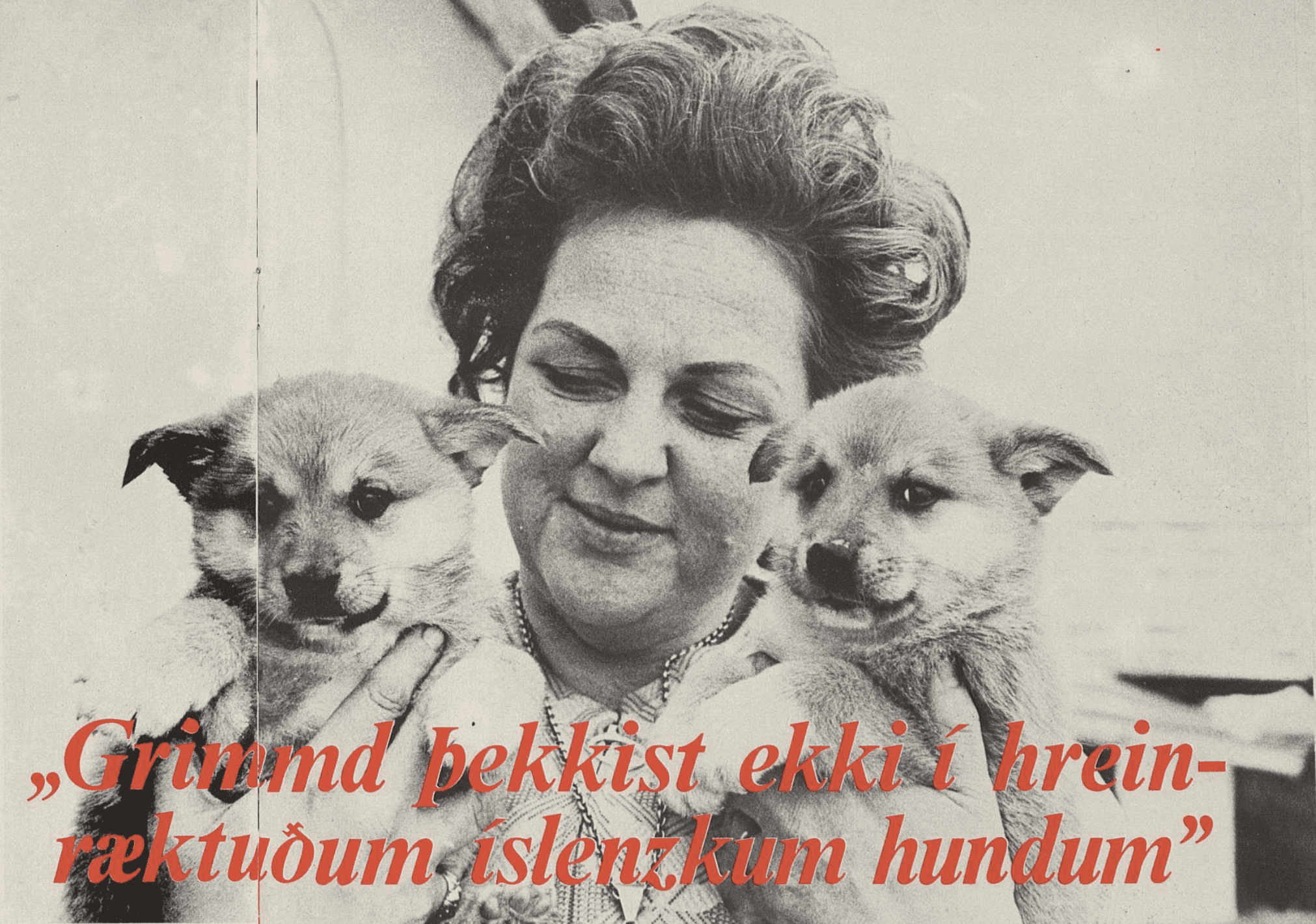Sigríður Pétursdóttir from Ólafsvellir

13.12.2023Evelyn Ýr
Sigríður Pétursdóttir (1934-2016) from Ólafsvellir in Skeiðahreppur unquestionably had the greatest role in saving the Icelandic Sheepdog breed in Iceland by starting breeding work in the sixties in collaboration with veterinarian Páll A. Pálsson at Keldur. Páll A. Pálsson sensed the danger facing the Icelandic dog population and had purebred Icelandic puppies bred from the remaining bitch in Keldur, one of the dogs that Mark Watson had collected for export. The bitch was called Pollý and came from Tálknafjörður in the Westfjords.
Sigríður also collaborated with Mark Watson and other parties in Britain who provided her with invaluable assistance and information about breeding. Sigríður then brought two females from Britain that Mark Watson gave her. The breeding stock in Iceland was very poor at that time, but Sigríður managed this extensive project.
Sigríður, along with several others, founded the Icelandic Kennel club in 1969. In 2008, she was honored with the Icelandic Falcon Order at Bessastadir for her work in the breeding of the Icelandic Sheepdog. You find a great article in English about Sigríður after Þórhildur Bjartmarz on her website Hundalífspóstur.
There is much of interest in old interviews and articles about Sigríður, which say so much about her view of the breed and her breeding goals. An article from 1973 quotes: “This (achievement of Icelandic dogs in foreign shows) is not due to me but only to a small degree, said Sigríður, but it is due to the fact that the Icelandic breed is of good quality. It has been preserved by individual farmers who have wanted to keep their own dog breedline and skilfully bred it. We owe it to these few farmers that the breed has been kept pure…the danger of degeneration is always present in such circumstances, but these old people knew what they were doing and they have managed to get a strong foundation without degeneration.”
When asked about the character of the dog, Sigríður replied: “The Icelandic dog is very strongly attached to human and is very sensitive to the feelings of its owner. They are very cheerful and follow the disposition of their owner. They are lively and entertaining if the owner is in such a mood, and they are calm if the master is calm. Aggression is not known in the pure-bred Icelandic dog. This quality has been eradictaed in the Icelandic sheepdog, because the farmers have put down aggressive dogs. Aggression is an unacceptable quality in the breed, since it is meant to drive livestock to and from, not to guard against attack as is expected of some other sheepdog breeds…in this way, this good character has been chosen and in my opinion, these qualities and cheerfulness are the strongest characteristics of the Icelandic dog.”
In an interview in 1978 published in Morgunblaðið, she spoke about the nature of the dog: "The Icelandic is considered the only one of these Spitz breeds living in the countries around the North Atlantic that is not aggressive. Furthermore, the Icelandic dog is very intelligent, even though it is slow to mature....The Icelandic dog is very attached to its human and needs to be around people a lot."
In one interview, Sigríður was asked about alspori dogs, which are dogs with double dewclaws on their hind and front paws. In the old days, it was believed that if a puppy was born as an alspori, it would be the best working dog.
"-- Is there any truth to this superstition about alspori dogs?
---Maybe this is just superstition like many other things. Another thing is that perhaps people have paid more attention to teaching alspori puppies, because they were sold at a higher price and it was thought that there was more hope for success. Then the puppy has had more opportunity to learn and become a better dog for the job." Source: Morgunblaðið, 1978
What it means to breed dogs from a stock with only a few individuals is well expressed in an interview from 2008: “What I found most enjoyable about my breeding at the time was that it was successful. But what was most difficult was when I chose the individuals that I could go on with breeding and had to let certain individuals go, had to put them down. I could not sell or keep more than a limited number of dogs which were not meant for further breeding. This was no 'production', but rather a precise and careful breeding and I had to choose and be careful about what I was doing. It wasn't finally possible to choose individuals to keep unless they were already of a certain age and when the traits, character, size and color could be seen. Everything had to be matched up as best as possible with what I was trying to achieve. The dogs had to be six months old before they could be evaluated and at that point they were already very attached to me.”
Sigríðurs words show that she had great responsibility in breeding the Icelandic Sheepdog. She also expressed her concerns that the popularity of the dog could increase too much. She said: "If the Icelandic Sheepdog becomes fashionable then they will start to produce him instead of breeding him."
I myself had never the honour to met Sigríður, but I have a lot of respect for this accomplished woman. I hope that her work to save the Icelandic Sheepdog will never be forgotten and will be kept alive for many years to come!
Picture: Víkan - 1973
Contact
Lýtingsstaðir, 561 Varmahlíð.
+354 893 3817
[email protected]


